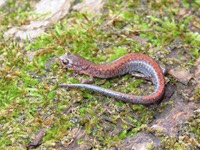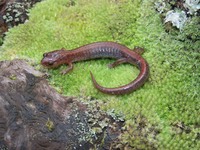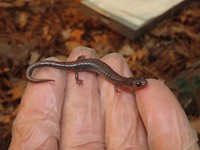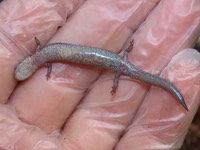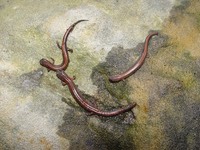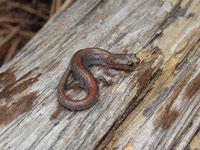
*The colored areas of the map above represent parishes with currently known records for the given species (Source: Jeff Boundy, LA Dept. of Wildlife and Fisheries). By no means does it represent the full range of the species in the state, nor does it necessarily mean that a species can be found throughout the parish with the record. This is provided as a guide to where you might be able to find these species in the state and to aid in identification. A descriptive explanation of the range of each species can be found in the text below.
Other Common Names:
Subspecies: No subspecies recognized.
Adult Description: Small, slender salamander (maximum 4.1”) with short legs, a round tail in cross section, and an orange to reddish stripe on top from neck to tail tip, usually more vibrant towards tail, with serrated edges along costal grooves. Reddish coloration may also be found on top of head, neck, and base of forelimbs. Sides are dark gray with scattered pale flecks. 18–19 costal grooves. Adult males possess crescent-shaped mental glands. Belly is somewhat translucent and mottled with gray and pale markings.
Similar Species:
Species Range: Known from four disjunct regions: northern Georgia and adjacent regions in Alabama, Tennessee and North Carolina, central and southeastern Missouri, west-central Arkansas and adjacent central Oklahoma, and central Louisiana.
Louisiana Range: Known from four parishes in Central Louisiana (Rapides, Natchitoches, De Soto, and Catahoula).
Adult Habitat: Well-drained, mature mixed pine-hardwood forests and longleaf pine woodlands with abundant rocks at or near surface.
Natural History: Southern Red-backed Salamanders are nocturnal and spend most of their lives underground. They prey upon a wide variety of invertebrates, with ants and beetles being most important in a Georgia study. Predators are unknown, but despite noxious skin secretions, they are likely taken occasionally by snakes, birds, and small mammals. Little is known of the reproductive ecology of Southern Red-backed Salamanders, especially in Louisiana populations. It is believed that egg-laying occurs in summer when females deposit 4–10 eggs in or under rotting logs or deeper underground. Females likely guard their nests by coiling around their eggs like other Plethodon. Eggs likely hatch in about 2 months. In a Georgia population that nested underground, offspring stayed near the nest site for months before being found on the surface in fall. Maturity may occur in 2–3 years. Longevity is unknown.
Best Time and Place to Observe: Take of Southern Red-backed Salamanders is prohibited in Louisiana, where they are known from only a handful of sites. Look for them in cooler months under logs or other cover in shaded mature forests or under rock at outcroppings in upland pine forests.
Global Conservation Status: Southern Red-backed Salamanders have a relatively wide distribution in the southeastern United States and a presumed large population, and thus, are listed as Least Concern by the IUCN Red List. Their NatureServe Global Conservation Status Rank is G5 (Secure).
Federal Conservation Status: None.
Louisiana Conservation Status: Southern Red-backed Salamanders have a ranking of S1 (critically imperiled because of extreme rarity – 5 or fewer known extant populations) in Louisiana. In Louisiana, Southern Red-backed Salamanders have a State Protection Status of ‘prohibited’, meaning possession or harvest of this species is illegal.
*** If you live in the range of this species in Louisiana and believe you may have observed this species please let me know (take a picture if possible), as there may be more unknown populations in the state.***
Author's Remarks: I have only found this species in Louisiana from seven different sites, six in Kisatchie National Forest in Natchitoches Parish and the other in Sicily Island Hills WMA in Catahoula Parish. The first Kisatchie site was an unknown site near a campground in March 2004, but the other site is well known and I have found them there in 2008, 2012, 2013, 2014, and 2017. One new site in Kisatchie was found in early 2023, two in early 2024, and one in early 2025. I finally found my first one in Sicily Island Hills WMA after several trips in late 2022.
